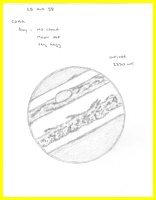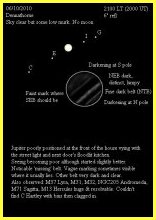





Conjunction of Jupiter with Venus March 2012
Jupiter is the largest planet in our solar system. A failed star, it is a 'gas giant', and it is its thick, poisonously gasious atmosphere that we see. The 'surface detail' we claim to see is actually the cloud tops. Jupiter has four moons easily seen by anyone with a small telescope or even a good pair of binoculars. Discovered by Galileo Galilei early in the 17th century, they are known as the Galilean Moons. Observing them orbiting Jupiter was proof enough that the Sun, and not the Earth, had to be at the centre of the solar system. With a large telescope it is possible to see the moons or their shadows transiting the planet's disc.
Jupiter came to prominence in July 1994 when it was struck by one of its orbiting comets, Shoemaker Levy 9. The comet impacted with such force that its effects were visible through my six inch telescope, although prior to the first impacts no-one really expected anything so dramatic. I, and everyone else, it seemed, was clouded out for the first few nights, so that when I finally put my eye to the eyepiece and saw Jupiter as I had never seen it before, it was really awe inspiring. And a little thought provoking, too, to think what that same comet could have done here on Earth. Jupiter acts as a bit of a 'dustbin' for us, capturing and ultimately disposing of debris that might otherwise impact the Earth. In fact Jupiter was probably an essential factor in the ability for intelligent life to evolve on Earth.
Jupiter's most famous feature, the Red Spot, is surprisingly difficult to see, and is sometimes even harder to see than at other times. It is an enormous and long lived storm, the like of which we thankfully don't see here on Earth. Like the Red Spot, the variations in the outer atmosphere which we see as the belts are not constant. In 2010 the Southern Equatorial Belt, normally one of the more distinct belts and on whose edge the Red Spot lies, almost disappeared, to return months later.